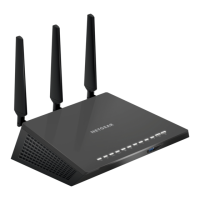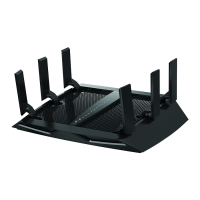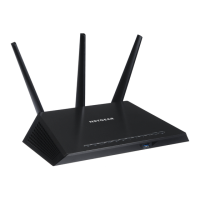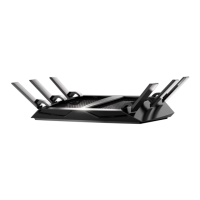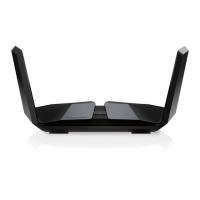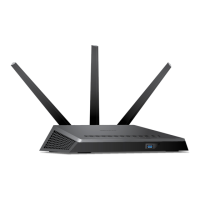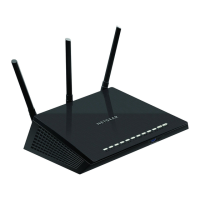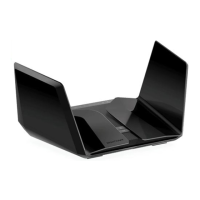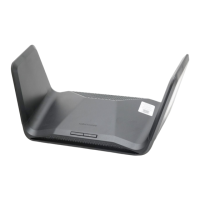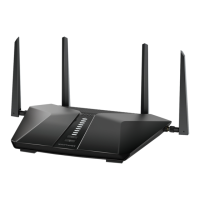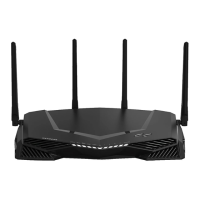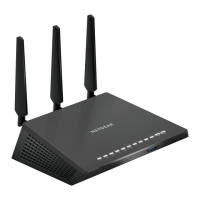
Do you have a question about the NETGEAR Nighthawk R7200 and is the answer not in the manual?
| Brand | NETGEAR |
|---|---|
| Model | Nighthawk R7200 |
| Category | Network Router |
| Language | English |
Details on router package contents and what is included with the device.
Instructions for connecting and positioning the router antennas for optimal signal.
Description of status indicators and control buttons located on the router's top panel.
Explanation of ports, buttons, and connectors found on the back of the router.
Location and function of the front-facing USB 3.0 port on the router.
Information found on the router's identification label, including login details.
Guidelines for optimal placement to ensure good WiFi signal coverage and performance.
Step-by-step instructions for connecting the router to the modem and power source.
Methods for connecting devices via wired Ethernet or WiFi to the router.
Explanation of different login credentials for ISP, WiFi, and router access.
Guide to using the mobile app for router setup and ongoing management.
Steps to access the router's web interface for configuration and settings.
Instructions for altering the language displayed in the router's web interface.
Step-by-step guide to automatically configure internet connection settings using a wizard.
Detailed instructions for manual configuration of internet connection parameters.
Configuration steps for internet connections that do not require login credentials.
Configuration steps for internet connections requiring ISP login details like PPPoE.
Guide to setting up IPv6 connectivity, including various connection types.
Explanation and adjustment of the Maximum Transmission Unit (MTU) for network performance.
How to manage device access to the internet using MAC filtering or access rules.
Method for blocking specific websites using keywords or domain names.
Instructions to block specific internet services or ports from external access.
How to remove previously blocked keywords from the site blocking list.
Steps to exempt a specific computer from internet access restrictions.
Managing lists of devices allowed or blocked from network access.
Setting up time-based rules for blocking internet access to sites and services.
Configuring the router to send email alerts for security events.
Accessing and modifying Wide Area Network (Internet) settings like port scan protection.
Configuring a Demilitarized Zone (DMZ) server for specific application needs.
Customizing the name of the router as it appears on the network.
Modifying local area network IP addressing, subnet mask, and RIP settings.
Configuring the range of IP addresses that the router's DHCP server assigns.
Steps to turn off the router's DHCP server functionality.
Assigning static IP addresses to specific devices on the local network.
Simplifying WiFi connection using Wi-Fi Protected Setup (WPS).
Configuring fundamental WiFi network parameters like SSID and security.
Adjusting WiFi data rates (Mbps) for different bands for optimal performance.
Modifying the WiFi network name (SSID) and encryption settings.
Creating a separate WiFi network for visitors with optional security.
Enabling or disabling the router's WiFi broadcasting capability.
Scheduling when the WiFi signal should be active or inactive.
Configuring Wi-Fi Protected Setup (WPS) parameters.
Configuring the router to function as a WiFi Access Point (AP).
Configuring the router to operate in bridge mode for wireless connectivity.
Creating bridges for specific network traffic management using VLANs.
Configuring a dedicated port for Internet Protocol Television (IPTV) service.
Manually defining network routes for advanced network configurations.
Using Quality of Service (QoS) to prioritize internet streaming traffic.
Creating QoS rules to prioritize traffic for specific connected devices.
Creating QoS rules to prioritize traffic based on specific applications or services.
Modifying existing Quality of Service rules for priority and other settings.
Removing specific Quality of Service rules from the router configuration.
Clearing all configured Quality of Service rules from the router.
Configuring WMM QoS settings for prioritizing WiFi voice and video traffic.
Enabling UPnP for enhanced network device communication and service discovery.
Checking for and installing the latest router firmware for new features and security.
Installing firmware from a local file on your computer.
Securing the router by changing the administrator login password.
Setting up a system to recover the admin password if it is forgotten.
Procedure to retrieve a forgotten router admin password using security questions.
Accessing general status and configuration details of the router, modem, and WiFi.
Viewing detailed traffic statistics for the router's internet connection.
Verifying the current status of the router's internet connection.
Reviewing records of router operations, security events, and network access.
Listing all computers and devices currently connected to the router.
Tracking and potentially limiting internet data usage volume.
Options for backing up, restoring, or resetting router settings.
Resetting all router configurations to their original factory defaults.
Loading previously saved router configuration settings from a backup file.
Enabling access to router settings and management over the internet.
Configuring the router for remote access and control from external networks.
Using the mobile app for remote router management and configuration.
Customizing the router's LED indicator behavior for network status.
Procedure to reset the router to its original factory state using the reset button.
Specifications and compatibility information for USB storage devices.
Steps for physically connecting a USB storage drive to the router's USB port.
How to access USB drive files and folders from a Windows PC.
Assigning a network drive letter to the USB storage on a Windows computer.
How to access USB drive files and folders from a Mac computer.
Using router software for automatic backups of Windows PCs to USB storage.
Using Time Machine for backing up Mac data to a router-connected USB drive.
Formatting and preparing USB drives for Mac backups using Disk Utility.
Steps to optimize Mac systems and settings for large data backups with Time Machine.
Detailed guide for performing Mac backups with Time Machine to a USB drive.
Allowing File Transfer Protocol (FTP) access to the USB drive within the local network.
Browsing folders available on the connected USB storage device.
Creating shared network folders on the USB drive for network access.
Modifying settings for existing shared folders on the USB drive.
Proper procedure for disconnecting USB drives from the router without data loss.
Configuring Dynamic DNS for remote access to the network using a domain name.
Enabling remote File Transfer Protocol (FTP) access to USB storage devices.
Setting up a personal FTP server using Dynamic DNS for remote access.
Detailed steps for configuring the personal FTP server using Dynamic DNS.
Creating a new account with a Dynamic DNS service provider like NETGEAR.
Using an existing Dynamic DNS account (NETGEAR, No-IP, DynDNS) with the router.
Modifying existing Dynamic DNS account configurations and settings.
Methods to access USB drives remotely via the internet, with or without Dynamic DNS.
Using NETGEAR ReadyCLOUD for remote file access to USB storage.
Steps to create a NETGEAR ReadyCLOUD account for remote access.
Linking your router to your ReadyCLOUD account for remote access.
Configuring the router as a DLNA/UPnP media server for compatible players.
Streaming music from USB storage to iTunes clients on computers.
Configuring the router's iTunes server for use with the iTunes application.
Using the Apple Remote app to control iTunes media playback from mobile devices.
Enabling TiVo compatibility for accessing media files stored on the router.
Configuring the router to use a custom Network Time Protocol (NTP) server.
Initial setup steps for connecting a USB printer to the router.
Obtaining the software needed to share printers connected to the router.
Installing the printer sharing software on computers that will use the printer.
Using the utility to send print jobs to the shared USB printer.
Monitoring the current state and availability of the shared USB printer.
Utilizing the scanning capabilities of a connected multifunction printer.
Adjusting settings for the NETGEAR USB Control Center printer utility software.
Overview of setting up rules for incoming traffic to specific local servers.
Step-by-step guide to configure port forwarding for specific services and applications.
Creating new port forwarding rules for services not predefined in the router.
Modifying existing port forwarding configurations for services.
Removing a specific port forwarding rule from the router's configuration.
Explanation of how port triggering works for dynamic port opening.
Configuring port triggering rules for specific applications and services.
Activating the port triggering feature on the router for dynamic port management.
General advice and quick steps for resolving common router issues.
Recommended order for rebooting network devices to fix connectivity problems.
Verifying physical connections for power and data cables.
Ensuring WiFi configuration matches on devices and the router.
Verifying computer/device network configurations for proper connectivity.
Interpreting router LED status indicators for diagnosing problems.
Troubleshooting steps for issues with the router's power indicator light.
Diagnosing problems when router LEDs remain constantly lit after startup.
Troubleshooting steps for missing link or activity lights on router ports.
Diagnosing why the WiFi status indicator light on the router is not illuminated.
Steps to resolve issues preventing access to the router's web interface.
Troubleshooting steps for when the router is connected, but the internet is inaccessible.
Diagnosing problems with loading web pages, such as traffic limits or DNS issues.
Resolving issues where router configuration changes are not applied or saved.
Diagnosing problems with connecting to the router's WiFi network.
Using the ping command to test network connectivity and troubleshoot issues.
Verifying the network path from a computer to the router using ping.
Checking network connectivity to external devices like ISP DNS servers.
Default configuration values for the router, including login and network settings.
Hardware and software specifications of the router, including protocols and dimensions.
